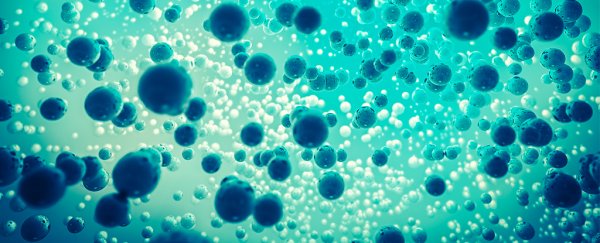Roughly 4 billion years ago an assortment of complex organic compounds went from being mere carbon soup to replicating biochemistry – the first steps to life on Earth.
The order of these steps has been a source of debate for decades. Now, a recent discovery about a common protein structure could help tip the balance, bringing us closer to understanding just how we came to be here.
Researchers from Eidgenössische Technische Hochschule (ETH) in Zürich have demonstrated that short strands of amyloid protein structures can direct the selection of amino acids to build even more amyloids.
If the word amyloid doesn't sound familiar, they're a protein structure that's increasingly being found all over the place in nature.
Part of the reason it's so common is that the amyloid has a special kink in it called a cross-β fold - this allows it to stick together into long, thin structures called fibrils.
You might have come across them in relation to Alzheimer's disease – that 'stickiness' can sometimes cause clumps of amyloid beta to aggregate in the brain and lead to the degeneration of neural tissues.
In fact it's this tendency to clump and cause disease that for a long time led scientists to consider amyloids to be a biological aberration.
But now it looks like its talents may have actually contributed to kick-starting life itself billions of years ago.
Just two years ago the ETH team found that peptides, which are chains of amino acids shorter than a typical protein - in this case just 5 to 14 units long - could spontaneously form amyloid structures in the presence of carbonyl sulphide.
Fibres made up of amyloids had already been shown to act as enzyme-like catalysts, prompting the scientists to wonder if their possible formation on ancient Earth played a role in helping other organic compounds come together in the days before cells.
Here the researchers take their hypothesis one step further by investigating whether amyloid sequences might also catalyse the construction of other peptides.
The team designed sequences of amyloids to act as the equivalent of DNA primer strands, and mixed them in with select quantities of other amino acids and a few helper chemicals.
By comparing the peptide sequences that resulted in these mixtures with ones that lacked designed 'primer' amyloid structures, the researchers found there was a huge advantage to having the amyloids in there.
"This ability also potentially applies to the amyloid itself – meaning the molecules can self-replicate," says chemist Roland Riek.
When it all boils down to it, life is special thanks to its ability to make imperfect copies of itself. Make enough copies, and some will do an even better job at replicating next time.
If we rewind the clock, we eventually get to a tricky question; was the simplest form of life based on replicating strands of nucleic acid as it is today, or replicating protein fragments?
Both benefit from catalysts - compounds that help speed the whole process up.
Proponents of the 'RNA world' hypothesis point to the physical properties of RNA to act as the original catalyst, building better and better nucleotide sequences using RNA machines until amino acids could be recruited later down the track.
We know RNA-like bases were around 4 billion years ago. But there have been questions over the availability of key elements needed to build the molecules, leading others to wonder if we should be looking down other paths.
Self-replicating protein fragments would pave the way for nucleotide chemistry, if only somebody could show how amino acids could form and help generate new peptides - and amyloids could be an answer.
"Additionally, amyloids are much more stable than early nucleic acid polymers, and they have a much simpler abiotic synthesis route compared to the complexity of known catalytic RNAs," says researcher Jason Greenwald.
To be fair, these were highly controlled laboratory conditions. It's a leap to go from tweaking proteins to generating life.
But the principle stands - short peptide sequences shaped like amyloids have what it takes to speed up the generation of similar amino acid sequences.
As with most things in biology, the origins of living chemistry are unlikely to be simple. Metabolic processes, RNA generation, and amyloid replication all could have been competing, clashing, and blending to form the first life in a primitive biochemical tango.
"We will never be able to prove which is true – to do so, we would have to turn back the last 4 to 4.5 billion years of evolution," says Riek.
"However, we suspect that it was not one, but multiple molecular processes with various predecessor molecules that were involved in the creation of life."
This research was published in Nature Communications.
